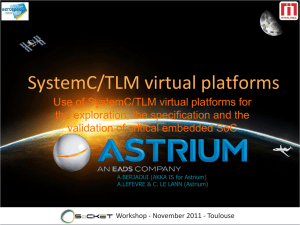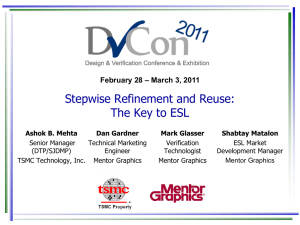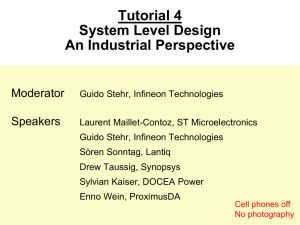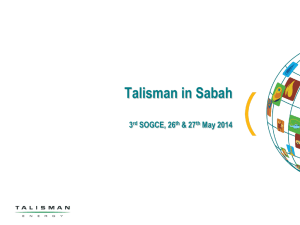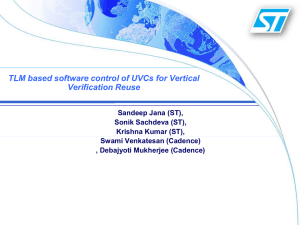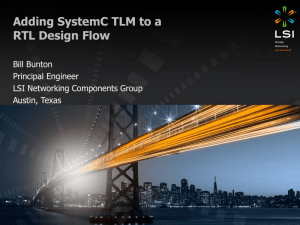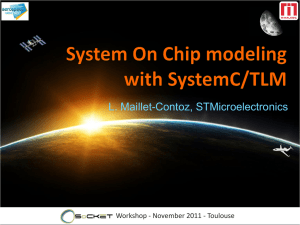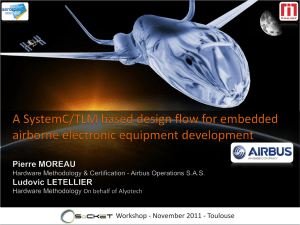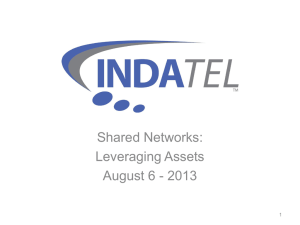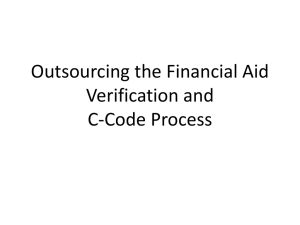Presentation
advertisement
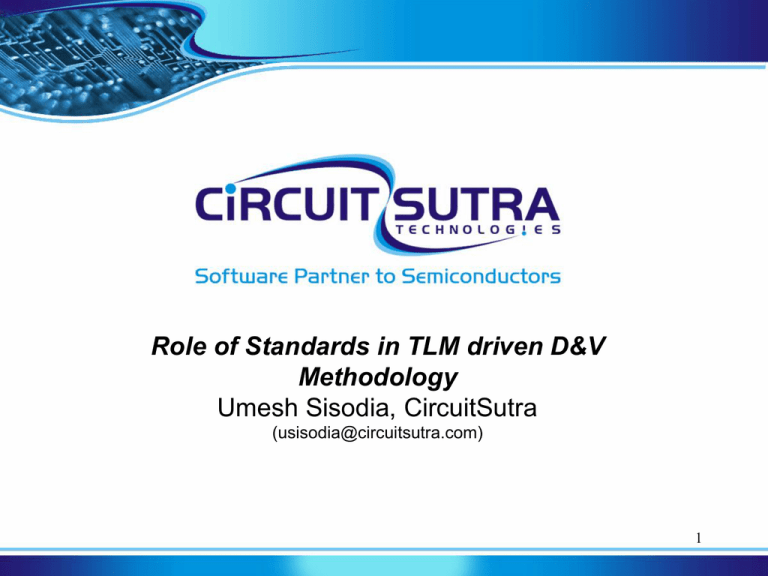
Role of Standards in TLM driven D&V Methodology Umesh Sisodia, CircuitSutra (usisodia@circuitsutra.com) 1 Objective CircuitSutra: SoC Modeling Services Embedded software services using Virtual Platforms By the end of session you should: Know about various standards in SoC modeling domain Role of standards in TLM D&V How does CircuitSutra’s expertise in SoC modeling standards fits with the Cadence tools to implement the TLM D&V Q&A session after the presentation Prize draw in the end. You can win a copy of the book ‘TLM driven design and verification methodology’ 2 Modeling Standards Modeling Language: SystemC Full power of C / C++ Structure (module, hierarchy, ports) Concurrency, Simulation time Precision: Fixed point and bit accurate data types Transaction level modeling (TLM) OSCI TLM2.0 OSCI TLM1.0 Extending TLM2.0 Bus specific protocols (AMBA, PLB, .. ) Non memory map protocols (UART, USB, Ethernet, .. ) STARC TLM Guidelines SystemC Synthesizable subset 3 Benefits of Standards Easy to integrate IP models from different sources Models are independent of ESL / EDA tool environment Any verilog code is supposed to work with EDA tool from any vendor Similarly SystemC models should work with any ESL tool (Necessary condition for SystemC to become a language of choice for design entry, and hence for raising the abstraction of chip design) Feasible to mix tools and expertise from different vendors in the TLM D&V Flow Virtual platform environment: ARM Fast Model, OVP, .. HLS: Cadence C-to-S Verification: Calypto, Cadence, SystemC Modeling Services (CircuitSutra) Different parts of a model can be sourced from different vendor The Untimed / Loosely timed model from one vendor can be combined with bus specific transactor from another vendor Allows the Code re-use across different applications / architectures Easy to get engineering professionals 4 Components of TLM D&V flow Cadence is advocating Standards based TLM D&V methodology Virtual Platform of a SoC TLM2.0 wrapper created over fast processor model Peripheral models created using SystemC & TLM2.0 Computation is separate from communication as per STARC TL Guidelines Synthesizable models for HLS Functionality implemented using Synthesizable SystemC subset Computation is separate from communication as per STARC TL Guidelines TLM Interfaces: TLM1.0 + GP (Borrowed from TLM2.0) = Cadence TLM+GP Bus specific Transactors (TLM+GP interface on one end, bus specific signal level interface on other end) Verification Verification of TLM Models (TLM2.0, HLS Ready TLM, HLS Ready Signal) Verification of RTL Blocks Accelara UVM can be effectively used to verifiy across abstraction levels HW / SW Coverification through Incisive Software Extensions (ISX) 5 Virtual Platform of SoC Allows the embeded software development without FPGA board Chip design and eSW can proceed in parallel. Reduces TTM for SoC Advanced tools are being available for better eSW development and debugging 6 VP Methodology A typical virtual platform project FIQ ARM CPU PIC IRQ ARMIntegratorCP Board Virtual Platform Environment ARM Fast Models, OVP, QEMU, .. Any other vendor .. DMA DecodeBus (m_bus) TLM Memory USB Controller Ethernet Controller UART Other Slave peripherals of ARM IntegratorCP Platform USB Backend USB driver of host PC TLM2.0 Sockets tlm_usb Socket tlm_ethernet Socket Ethernet Backend Uart backend Ethernet driver of host PC Driving the console tlm_uart Socket New SystemC models added Existing components of ARMIntegratorCP platform Models for Virtual Platforms TLM 2.0 Model Ethernet Controller TLM-Ethernet Extends TLM2.0 Backend Traffic Backend Generator Virtual Network Ethernet Driver (Host PC) Ethernet Controller Ethernet Controller Accessing host interfaces in VP Guest Guest OS OS Android / Symbian Application Device Driver TLM 2.0 USB Ethernet Host Controller VP TLM-USB TLM-Ethernet Extends TLM2.0 Backend Host OS Windows 7 / Linux Ethernet USB Driver Driver (Host PC) •Enables the virtual platform to interface with real world devices •Provides real time verification environment •Any hardware interface of host PC can be supported •Ethernet •WLAN •USB •Printer •Camera •Audio(Speaker, Mic) •.. Model Architecture STARC TL Guidelines: Computation is separate from communication Wrapper Wrapper Core (Functional model) Communication TLM2.0 Socket Adaptor (PV – CA) BS) CA TLM Socket Pin level interface OCP PLB AXI TLM2.0 Compliant Bus Cycle Signal Accurate Interface ModelModel Blocking Interface (LT / UT) Can connect Non blocking to interface the RTL(AT) Non blocking interface (AT) TLM2.0 Pin interface extended is specific for Bus to specific a bus protocol High Level Synthesis Benefits SystemC: Language of Design entry •Only one version of design Designers focus implementing the •Less amount of on code functionality •Fewer bugs TLM model SystemC, C, C++ TLM-GP Interfaces Function is seperated from implementation Raises the abstraction of Chip Design SystemC may replace Verilog Constraints HLS Tool C-to-Silicon Compiler CircuitSutra have goodoptimized expertiseRTL in HLS Tool: Generate Synthesizable SystemC subset Optimized For: Bus Constraints Process Underlying Architecture Node Fabric Transactors RTL RTL (Verilog) RTL FPGA Power 90 AXI nm Altera FPGA 45 Area PLB nm Xilinx RTL ASIC Performance 22 OCP nm 11 Models for VP & HLS Virtual Platform HLS • Simulation Speed •Synthesizability • Can use all the constructs of SystemC •Only Synthesizable subset of SystemC should be used •TLM2.0 for bus interfaces •TLM1.0, TLM+GP (Cadence) •TLM interfaces for non memory mapped connections •Pin level interfaces for non memory mapped connections 12 Models for VP & HLS Virtual Platform HLS TLM-UART Sout Sin Core (SystemC) Core (Synthesizable SystemC) Communication (TLM2.0) Communication TLM+GP Modem TRANSACTOR HLS Ready Signal TLM 13 Verification from TLM to RTL New verification methodology required for new design methodology Effortlessly reuse verification IP from TLM to RTL closure The proven RTL verification concepts (UVM, MDV etc.. ) can be used The UVC can be extended to verify SystemC based TLM designs Complete System (HW & SW) Incisive Software extensions (ISX) enables the verification environment to connect to software using Generic Software adaptor (GSA) Reduce the verification efforts The functionality of the computation block should be verified at the highest abstraction level Fewer bugs Faster simulation Easier to identify, understand and fix the bugs The interfaces, protocol correctness can be verified at HLS ready level Detailed timing can be verified at RTL level 14 HW/SW Co-Verification Software UVC BUS UVC Automatic System scenario generator UVM Infrastructure I S X Hardware Software SoC (VP) Peripheral UVC Peripheral UVC Incisive Software Extensions (ISX) •Extends system verification environment to include software •MDV can be applied to verify the low level hardware dependent software CircuitSutra can integrate the VP with ISX Standardization required .. TLM modeling standard for non memory mapped communication protocol USB Ethernet WLAN Zigbee .. Standard definition of abstraction levels for different use cases PV, AV, VV OCP-IP: TL4, TL3, TL2, TL1 STARC TL Guidelines: 16 System Realization Alliance Advocating Standards based TLM D&V methodology Standards based SoC modeling services Can help mutual customers to quickly get started with TLM D&V 17 CircuitSutra Offerings Create virtual platform of System on Chip (SoC) Integrate the Virtual platform with Cadence ISX Synthesizable models for High Level Synthesis (HLS) Create models as per SystemC Synthesizable subset Synthesize using C-to-Silicon compiler SystemC models for RTL verification or HW / SW coverification Bus specific Adaptors / Transactors OCP-IP AMBA Kit Embedded software services using virtual platforms 18 We help the Semiconductor Companies to Quick Start their Electronic System Level (ESL) activity Thank You! 19

